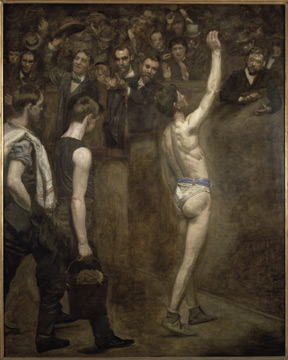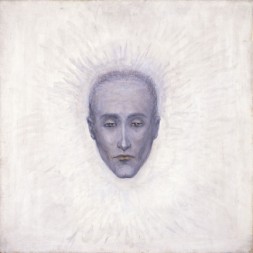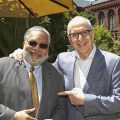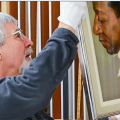‘Hide/Seek: Difference and Desire in American Portraiture”
(Image: Detail from River Front No. 1 by George Wesley Bellows. Oil on canvas, 1915.)
The National Portrait Gallery will present the first major museum exhibition showing how questions of gender and sexual identity have dramatically shaped the creation of modern American portraiture. “Hide/Seek: Difference and Desire in American Portraiture” will be on view at the museum Oct. 30 through Feb. 13, 2011.
Long before the advent of today’s gay and lesbian civil rights movement there were many examples of art—paintings, sculptures, water colors, prints and photographs—that acknowledged a variety of sexual identities. This exhibition features artists and sitters with a range of identities, from exclusively same-sex to exclusively heterosexual.
“The exhibition is titled, ‘Hide/Seek: Difference and Desire in American Portraiture’ because those with different sexual identities—who are of, but not fully a part of, the society they portrayed—occupied a position of influential marginality,” says David Ward, co-curator of the exhibition and NPG historian. “From this vantage point they crafted innovative and revolutionary ways of painting portraits. Society’s attempt to forbid them forced them to resist by developing new visual ways to code, disguise and express their subjects’ identities—and also their own.”
The exhibition will examine such themes as the role of sexual difference in depicting modern Americans, how artists have explored the definition of sexuality and gender, how major themes in modern art—especially abstraction—were influenced by this form of marginalization and how art reflects society’s changing attitudes.
The installation begins with late 19th-century works by Thomas Eakins and John Singer Sargent and charts 20th-century portraiture with 105 major works by masters, including Romaine Brooks, George Bellows, Marsden Hartley and Georgia O’Keeffe. It continues through the postwar period with works by Jasper Johns, Robert Rauschenberg, Agnes Martin and Andy Warhol. The exhibition addresses the impact of the Stonewall Riots of 1969, the AIDS epidemic and the advent of postmodernist attention to identities, indicating how portraiture repeatedly negotiated seismic shifts in American culture and society. “Hide/Seek: Difference and Desire in American Portraiture” continues through to the end of the 20th century with major works by artists such as Keith Haring, Glenn Ligon, Nan Goldin, Felix Gonzalez-Torres, David Wojnarowicz and Catherine Opie.
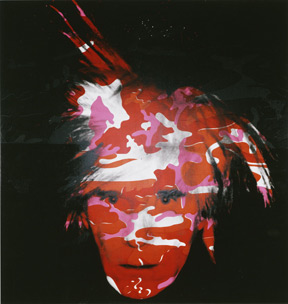
Camouflage Self-Portrait by Andy Warhol. Synthetic polymer paint and silkscreen on canvas, 1986. © 2001 The Andy Warhol Foundation for the Visual Arts, Inc./Artists Rights Society (ARS), New York
According to museum director Martin Sullivan, “‘Hide/Seek: Difference and Desire in American Portraiture’ surveys more than 100 years of compelling expressions of American art and reveals another layer of American social history, one that greatly influenced these artists’ work and American art as a whole.”
Among the objects in the exhibition are “Salutat” by Eakins; “Painting No. 47, Berlin” by Hartley; Brooks’ 1923 oil-on-canvas self-portrait; “Rrose Selavy (Marcel Duchamp), 1920” by Man Ray; a photograph of Janet Flanner taken in 1927 by Berenice Abbott; “Canto XIV [from XXIV Drawings from Dante’s Inferno]” by Rauschenberg; “We Two Boys Together Clinging”by David Hockney; “Troy Diptych” and “Camouflage Self-Portrait” both by Warhol; “Souvenir” by Johns; “Felix, June 5, 1994”, by AA Bronson; and “Ellen DeGeneres in Kauai, Hawaii” by Annie Leibovitz.
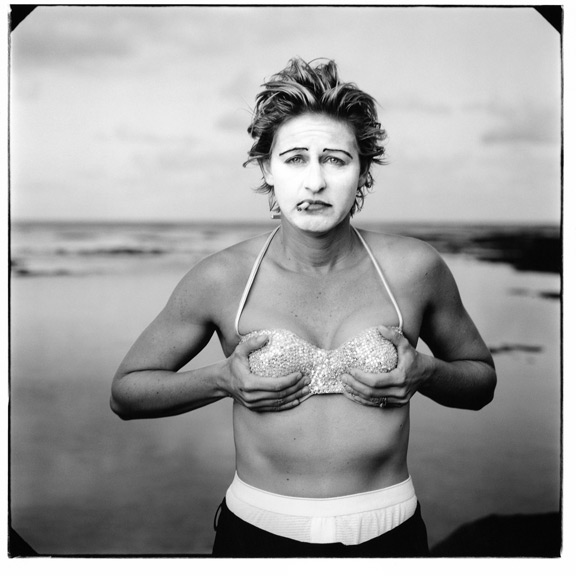
Ellen DeGeneres, Kauai, Hawaii by Annie Leibovitz. Gelatin silver print, 1997. © Annie Leibovitz, 2010
Co-curators of this exhibition are Ward and Jonathan Katz, director of the doctoral program in visual studies, State University of New York at Buffalo.
________________________
UPDATE Dec. 10, 2010
1. Does the Smithsonian stand behind the “Hide/Seek” exhibition or are you going to close the show?
The “Hide/Seek: Difference and Desire in American Portraiture” exhibition at the Smithsonian’s National Portrait Gallery is a serious examination of the role sexual identity has played in the creation of modern American portraiture. The Smithsonian Institution stands behind the exhibition, and the show will remain open through the scheduled date of Feb. 13.
2. Why did the Smithsonian make the decision to remove the “Fire in the Belly” video by David Wojnarowicz from the exhibition?
Many people who contacted the Smithsonian and some members of Congress were upset about segments of the four-minute video (optionally accessed by visitors on a small touch screen in the exhibition) because it depicted a crucifix on the ground with ants walking on it. They interpreted the video imagery as anti-Christian.
This imagery was part of a surrealistic video collage filmed in Mexico expressing the suffering, marginalization and physical decay of those who were afflicted with AIDS. In the video, Wojnarowicz used religious imagery placing his work firmly in the tradition of art that uses such imagery to universalize human suffering.
Smithsonian officials and museum leaders are sensitive to public perceptions of the Institution’s exhibitions. In this case, they believed that the attention to this particular video imagery and the way in which it was being interpreted by many overshadowed the importance and understanding of the entire exhibition. Thus the decision was made to remove the video from the exhibition.
3. Who made the decision?
The Secretary of the Smithsonian, after hearing the opinions and views of the relevant parties, including the Under Secretary for History, Art and Culture, the National Portrait Gallery Director and the exhibition co-Curator.
4. How do you respond to critics, including the Association of Art Museum Directors, who say that you caved into conservative critics who think it’s okay to censor art exhibits in museum?
We respect the AAMD position, and respectfully disagree with their conclusion. As a publicly supported museum, the Smithsonian has an important research and educational mission and needs to be responsive to a large and diverse audience. The change that was made was intended to clear up a misunderstanding, and help focus attention on the central theme of the exhibition, which is portraiture and the representation of gay and lesbian identities in American art.
5. What are you doing to warn visitors who may find the exhibition disturbing?
Acknowledging that some visitors may prefer not to encounter some of the subject matter in the exhibition, signs at both entrances read: “This exhibition contains mature themes.”
6. Why did you remove two protestors who showed the video inside the museum at the entrance to the exhibit? Were these two protestors banned for life by the Smithsonian?
The two people were asked to leave the museum because they were violating Smithsonian policy: They were videotaping in a no-photography area; distributing leaflets; and displaying a placard (iPad) – all of which are prohibited in Smithsonian museums. When the protestors refused to leave, Smithsonian security contacted the Washington, D.C. Metropolitan Police Department. The police did not arrest them. The Metropolitan police issued the protestors a citation (barring notice), which states they are barred from the building for 12 months. The protestors were not banned from the museum for life.
The Smithsonian’s statement of support for the “Hide/Seek” exhibition can be found here.
Posted: 25 October 2010
- Categories:
